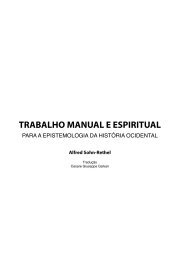Perversion the Social Relation
Perversion the Social Relation
Perversion the Social Relation
- No tags were found...
You also want an ePaper? Increase the reach of your titles
YUMPU automatically turns print PDFs into web optimized ePapers that Google loves.
98 Nina Schwartzat her. Francis, we will much later learn, is a tax auditor soon to beginhis investigation of Thomas for tax fraud. 16 Following Christina's danceand <strong>the</strong>n his own private lap dance, Francis goes to <strong>the</strong> men's room, apparentlysexually aroused, while Eric and Christina look ambiguously ateach o<strong>the</strong>r, suggesting <strong>the</strong> existence of a complex relationship between<strong>the</strong> two.The film's opening introduces most of its major characters in <strong>the</strong> contextof sexuality mediated by ei<strong>the</strong>r money and "art"—<strong>the</strong> ballet as astrategy for picking up men—or money and artifice—as in <strong>the</strong> repetitivestaginess of <strong>the</strong> Exotica dancers' performances. In fact, it would be difficultto count <strong>the</strong> numbers of times money is passed from one character toano<strong>the</strong>r. Egoyan thus suggests <strong>the</strong> creepiest dimensions to <strong>the</strong>se characters,who seem not just deceptive but sexually predatory (Thomas at <strong>the</strong>ballet; <strong>the</strong> men at <strong>the</strong> dance club) or sexually manipulative (<strong>the</strong> dancersand pregnant club owner, Zoë [Arsinee Khanjian, Egoyan's wife]), exploiting<strong>the</strong> spectators' frustrations for financialgain or some o<strong>the</strong>r kindof power. Such implications are intensified in a particularly disturbingway when we later see Francis dropping off a thirteen- or fourteen-yearoldgirl, Tracey (Sarah Polley), in front of a neon-lit storefront. Whenhe <strong>the</strong>n pays Tracey, we can't help but suspect that her services havebeen sexual, despite <strong>the</strong> fact that <strong>the</strong> scene includes banal dialogue innormative tones: "Are you free next Thursday?" "I think so."The film, that is, chooses to introduce us to a world that seems notjust tawdry but perhaps criminally exploitative with its suggestions ofchild porn (on one occasion, Eric introduces Christina as "a sassy bitof jailbait") and childhood sexual abuse (Francis and Tracey). What wewill ultimately learn, however, is that <strong>the</strong>se apparently consciencelesspeople engaged in various exploitations of o<strong>the</strong>rs' weaknesses are <strong>the</strong>mselvesall mostly very nice, not particularly exploitative people workingin not particularly successful ways to cope with loss. Some of <strong>the</strong>se lossesare conventional and not especially dramatic, and some are profoundlytraumatic; some are clearly articulated in <strong>the</strong> film, and o<strong>the</strong>rs are onlyhinted at.One question <strong>the</strong> film raises, <strong>the</strong>n, is why it should initially chooseto display its figures in <strong>the</strong> most aggressively unflattering and disturbingpossible light, only to frustrate <strong>the</strong> expectations that such a portrayalraises. Egoyan, that is, chooses to invert <strong>the</strong> strategy of David Lynch in








